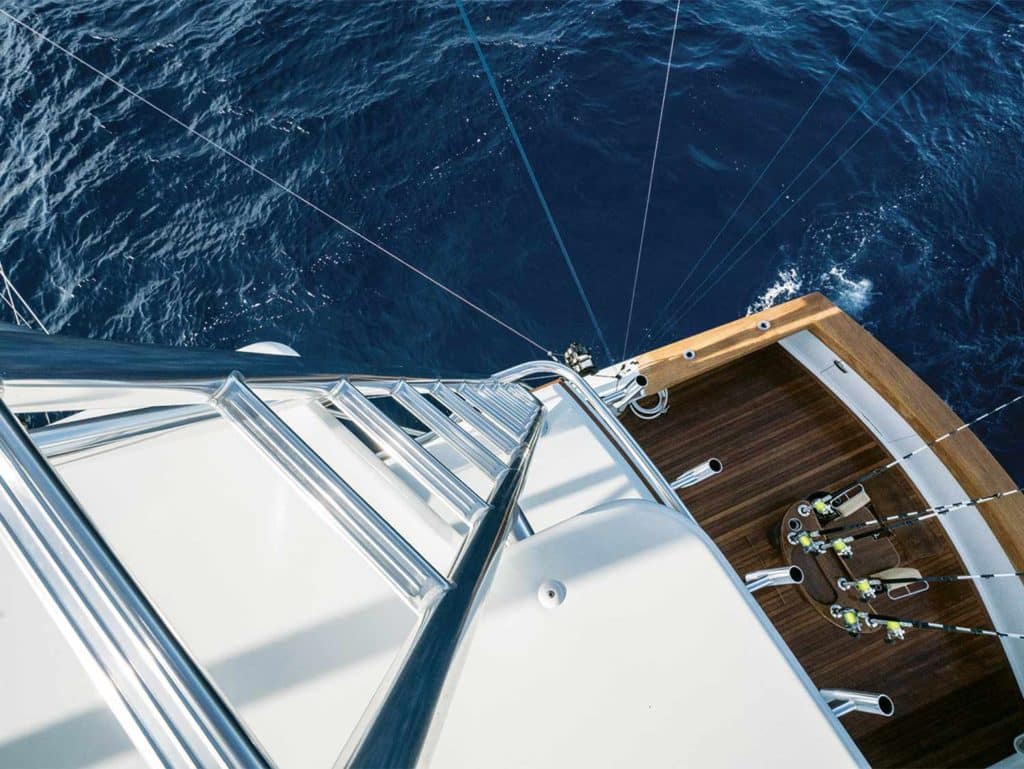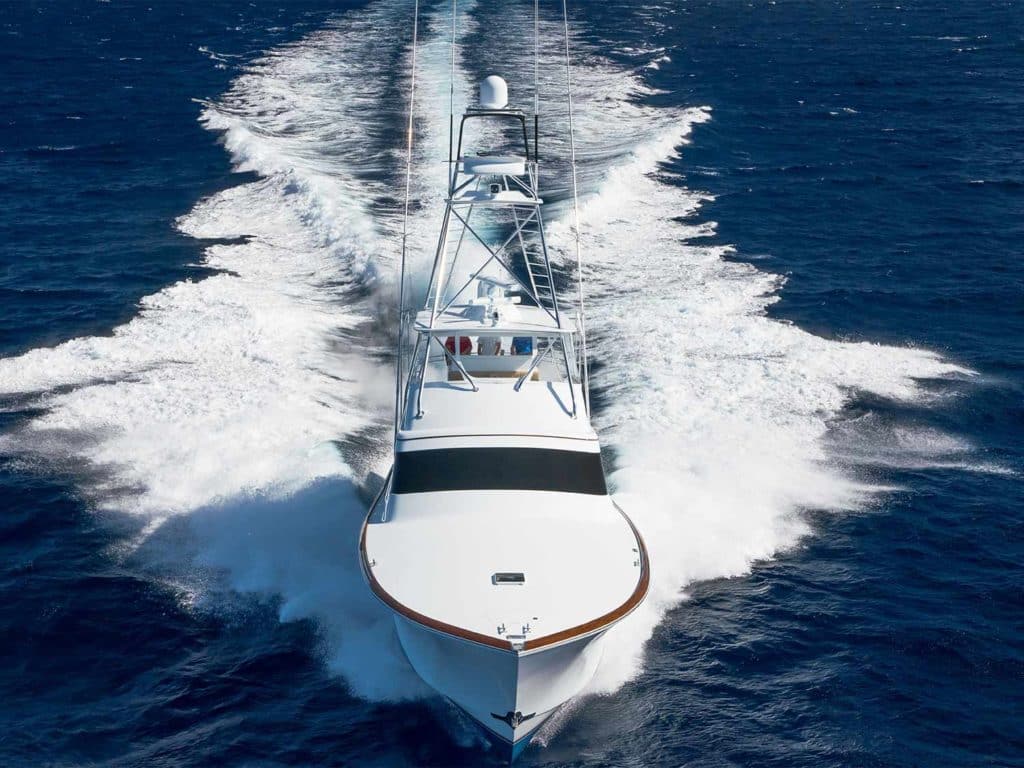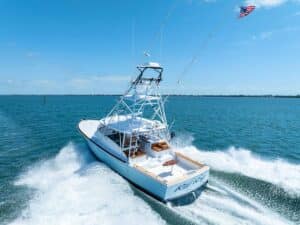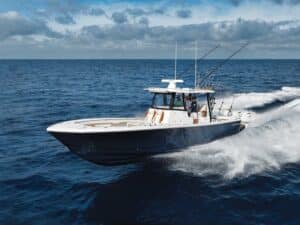
Since 1987, Mon Chari owner Damon Chouest has caught more than 2,000 blue marlin while fishing the waters of the Gulf of Mexico, Costa Rica, Venezuela, Tonga, the Dominican Republic and the Virgin Islands. While much of this 68-footer was built under the watch of Capt. Dave Dalfo, it’s obvious the boat had been designed to not only travel swiftly, but also to catch fish in comfort, style and safety—features that both Chouest and her captain, Matthew Coppoletta, no doubt appreciate.
Shakedowns and sea trials are vital tests to validate the seaworthiness and proper function and performance of a ship’s systems. The wringing-out process takes as much time as needed before the boat is set free to head offshore and begin its career on the water. However, the new American Custom Yachts 68, Mon Chari, followed a slightly different path, originally leaving the Stuart, Florida, facility not for local waters, but rather for a 1,000-plus-mile journey to the Virgin Islands, where the boat was promptly christened with a first-place win at the 2019 Scrub Island Invitational with less than 100 hours on her. I was able to get on board this new build just before Coppoletta was pulling out for a two-day passage to Mon Chari’s home port in Louisiana.
Cockpit
The 68′s cockpit is all about form and function. With a BlueWater fighting chair as the centerpiece, it’s flanked with sizable hatches both fore and aft. The forward hatch conceals a massive ice bin, which is supplied by a pair of ice chippers. The hydraulic steering, bilge and livewell pumps in the lazarette are accessed from the aft hatch, and the hatch’s stainless-steel framework provides deep gutters to direct water overboard and maintain a dry bilge.
Substantial built-in storage is provided throughout the forward portion of the cockpit, including the mezzanine to starboard, revealing careful planning and execution for offshore work. Beneath the mezzanine seating is a massive bait freezer, but another freezer/chill box on the port side supplies capacity for several days of ready-to-go rigged baits. Two additional deep and insulated drink boxes are built into the mezzanine deck, as is the engine room access. More storage is available on the port side of the electric salon door under the flybridge ladder. Flush-mounted rod holders line the teak covering boards, rods can be stowed in the legs of the high-polished Bausch-American tuna tower, and chilled-water air conditioning flows from the bridge overhang.

Engine Room
The almost-sterile engine room is home to a pair of Caterpillar C32A 1,925 hp diesels, the headroom between the engines is around 6 feet, with 4 feet of open space between them and ample room to get around each one. An auxiliary 80-gallon tank carries fresh oil, and sight gauges monitor fuel levels. Aft of each engine is a Seakeeper 5 gyrostabilizer, while forward to port and starboard are the Phasor 23 kW generators.
Dometic air chillers, pumps, a watermaker and Spot Zero, among other equipment, including the hull tube for the Furuno full-circle scanning sonar, are housed in a separate walk-in pump room ahead of the forward bulkhead. Raw-water cooling for ancillary equipment is supplied with a dedicated sea chest to enhance flow and reduce maintenance and clutter. The decreased number of hull penetrations also pays off in performance. The cooling water for the gyros is supplied by a closed system fed from the chilled-water air-conditioning system, and the fuel tanks vent into the hullside air boxes for a neat and polished look.

Interior
Mon Chari’s teak interior is a strategic alliance: West Coast yacht manufacturer Westport cut the interior woods on CNC routers before shipping them to ACY, where they were assembled and installed. The rich grain of wood surrounds the salon with a plush ambience, while the L-shaped lounge and leather ottoman to starboard fill the social area with comfort and provide rod storage underneath. The peninsula-style galley features cored granite countertops, undercounter refrigeration, a stainless-steel sink, a microwave and an electric cooktop. Three bar stools and a curved dinette to port provide a good eating space, all the while keeping the galley area open.
Watch: Learn to rig a swimming Spanish mackerel here.
Below, the master stateroom has a queen berth and en suite head and shower. A second queen bed is in the forward VIP stateroom, also with a private head. The starboard stateroom features upper and lower berths, and shares a head and shower with the single-berth stateroom to port. The companionway houses a floor-to-ceiling laundry center.

Flybridge and Performance
The bridge has a walkaround center-console helm with great visibility forward—courtesy of C-Worthy Custom Yacht Canvas’ hard-glass acrylic enclosure—as well as aft and down into the cockpit. Three BlueWater chairs line the command deck, and more seating with storage underneath is located forward. A pair of freezers are built into the forward brow, and the bridge wings provide additional rod storage.
With its own marine-electronics division, ACY’s Steven Loehrig was on board for our sea trial to knock out some last-minute punch-list items. Three 22-inch Garmin MFD screens displayed myriad details from the Furuno, Simrad, Icom and Garmin electronics.
Mon Chari was heavily loaded with fishing gear, bait, additional live-bait wells, spare parts, and enough fuel for the trip to Louisiana, yet when we let all of her ponies out of the stable, she ripped up to a top speed of 39.8 knots, turning 2,300 rpm on the St. Lucie River. At 1,870 rpm, we read 32.8 knots, and at 1,900 rpm, we saw 33.9 knots. ACY president Dominick LaCombe Sr. reports that Mon Chari is every bit a 42-plus-knot ride.
Equally impressive is her response and handling. When Coppoletta gave me the wheel, I immediately noted the intense maneuverability and how it handled like a much smaller boat. Mon Chari sliced through turns and backed down effortlessly.

Construction
American Custom Yachts has been building cold-molded custom boats since 1992, and this latest model wears its pedigree proudly with flawless perfection. The hull is formed on a laser-cut steel jig with a laminated fir keel, stem, stringers and longitudinals, and is diagonally planked with multiple layers of okoume plywood. After the first layer is mechanically fastened, additional layers are vacuum-bagged in a total of three layers along the bottom and two layers on the hull sides and transom. The hull is then covered with Kevlar and fiberglass mat; minimal fairing is needed thanks to the smooth surface afforded by the vacuum-bag process.
After the hull is flipped, the plywood bulkheads and interior are finished with fiberglass. The hull structure’s weight benefits from the strength of the plywood core and thinner panels, as opposed to foam-core-encapsulated construction.
Read Next: Learn more about the history of American Custom Yachts.
Deckhouse and flybridge construction are fabricated from a limited-production mold using fiberglass cored with foam, and all of the exterior, bilges and lazarette finish work is swathed in shiny Awlgrip.
The transom, salon door, toe rail, deckhouse haunches, helm pod, half-round and flybridge cap-rail trim are painted faux teak.
The combination of power, the running surface and the efficacy of the 68′s swept-back six-sided rudders had me soon realizing this boat doesn’t wait to show off its maneuverability—it is constant. I wish I had the time to take that ride to the Pelican State aboard this charmer. Bow to stern, Mon Chari is a just another gleaming example of the boatbuilding expertise you get from American Custom Yachts.
Specs
- LOA: 68′4″
- Beam: 18′7″
- Draft: 5′7″
- Displ: 96,000 lb.
- Fuel: 2,300 gal.
- Water: 240 gal.
- Power: Twin C32A Caterpillar 1,925 hp
- Gear/Ratio: ZF/1.963:1
- Propellers: Veem, 5-blade
- Paint: Awlgrip
- Climate Control: Dometic










